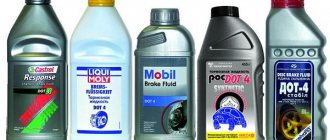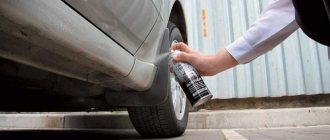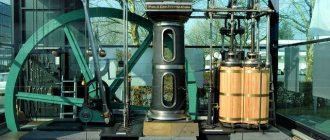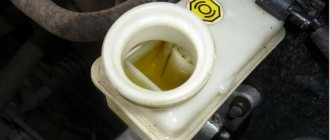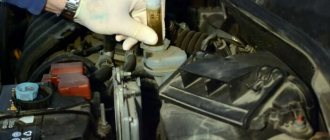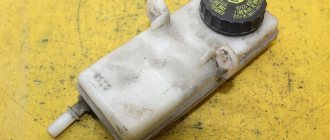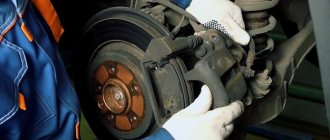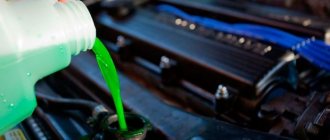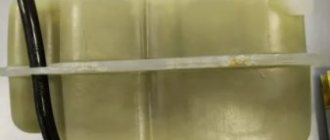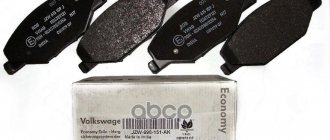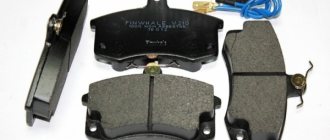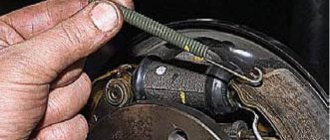Description of brake fluid Castrol Brake Fluid DOT 4
Castrol Dot 4 is a brake fluid with an extremely high boiling point. It has a yellow transparent color and a uniform consistency without any dry residue.
Castrol Dot 4 brake fluid is developed on the basis of polyalkylene glycol and multi-component boron ethers with the subsequent addition of an additive package. Corrosion inhibitors protect the brake system from rust and premature wear, and anti-cavitation additives prevent the formation of vapor locks at high temperatures and excessive loads.
Density of DOT-5 silicone fluid
DOT-5 fluid consists of a silicone base with the addition of additives for various purposes, generally the same as in other compounds for brake systems.
The density of silicone fluids used to create working compounds for brake systems is less than that of water. It is approximately 0.96 g/cm3. It is impossible to determine the exact value because silicones do not have a strictly defined length of siloxane units. The situation is similar to polymers. Up to 3000 units can be assembled into a chain of a silicone molecule. Although in fact the average length of a molecule is much less.
Additives lighten the silicone base somewhat. Therefore, the density of ready-to-use DOT-5 brake fluid is approximately 0.95 g/cm3.
Specifications
| Name | Meaning | units of measurement |
| Appearance | Clean and transparent, yellow in color | Visually |
| Relative density at 20°C, g/ml | 1.07 | IP 160 |
| Equilibrium boiling point of a “dry” liquid (ERBP), °C | 250 (min.) | ASTM D1120 |
| Equilibrium boiling point of a “wetted” liquid (WET ERBP), °C | 155 (min.) | SAE J1703 |
| Kinematic viscosity at 100°C, mm²/s | 2.3 | ASTM D445 |
| Kinematic viscosity at -40°C, mm²/s | 1200 (typical) | IP 71 |
| pH | 7.3 | SAE J1703 |
Brake fluid and everything you need to know about it
Even those who got a C in chemistry understand that brake fluid is a multicomponent composition, sometimes quite complex. This composition must meet a lot of requirements in order for the car to obediently stop when you press the brake pedal. And the harder you press, the more intense the braking will be. This cannot be achieved with poor, low-quality or worn-out fluid. That’s why it won’t hurt to spend a few minutes on the properties and characteristics of the brake fluid.
ABRO DOT4 brake fluid
Brake fluid is designed to replace the mechanical drive of the brakes - to transfer force from the pedal to the working brake mechanisms as quickly and accurately as possible. To do this, the fluid must be incompressible, otherwise we simply do not have enough pedal travel to lock the wheel. In no case should the liquid boil, since during the boiling process steam is released, which creates compressible air pockets and the pedal will fall to the floor without blocking the wheel. It should also not freeze or absorb moisture.
In order to somehow systematize the requirements for the boiling point and viscosity of a liquid, the US Department of Transportation (DOT) developed standards that we still use today. (Federal Safety Standard FMVSS No. 116). Theoretically, a distinction is made between the boiling point of a dry liquid (without water impurities) and with a minimum permissible 3.5% moisture. Viscosity is determined at border temperatures, from +100°C to -40°C. Europe adopted the same standards and documented them in national registers (ISO 4925, SAE J 1703).
Method and conditions of use
Liter packaging
Castrol Dot4 brake fluid is poured into the brake fluid reservoir. For the vast majority of cars, it is located under the hood and is a plastic container with a lid.
In the event that brake fluid needs to be topped up because it has leaked or evaporated, or the brake system has been repaired, the product is poured to the level marked on the reservoir.
There are situations when the fluid must be completely replaced. Lubricant manufacturers recommend changing this product every two years to ensure its quality is always at an unsurpassed high level. In this case, the motorist can look at the consumption of a special fluid in the service book or also rely on the level marked on the tank.
An important indicator of brake fluid level is the parking brake icon. If the parking brake lever is lowered and the light is on, this means that there is not enough brake fluid in the system or an air lock has formed.
How to check the density of brake fluid?
It is difficult to imagine who and for what purposes outside industrial conditions may need such a procedure as measuring the density of brake fluid. However, there is a method for measuring this value.
You can measure the glycol composition with the same hydrometer designed for measuring the density of antifreeze. The fact is that antifreeze uses ethylene glycol, a related substance, as a working base. However, the error will be significant when using this technique.
The second method will require accurate scales (the smaller the division scale, the better) and a container that holds exactly 100 grams (or 1 liter). The measurement procedure using this method is reduced to the following operations.
- We weigh dry, clean containers on scales.
- Pour exactly 100 grams of brake fluid.
- Weigh the container with the liquid.
- Subtracts the tare mass from the resulting weight.
- Divide the value obtained in grams by 100.
- We get the density of the brake fluid in g/cm3.
The second method, with some degree of error, can measure the density of any liquid. And do not forget that the density is significantly affected by the temperature of the composition. Therefore, the results of measurements taken at different temperatures may vary.
Advantages and disadvantages
Castrol dot4 has one small drawback - its price is much higher than its Russian counterparts. Also, the product cannot be found at every gas station or small auto store. Due to its low popularity, only large enterprises selling auto goods or specialized Castrol stores sell it.
However, Dot 4 Castrol brake fluid has many undeniable advantages, allowing it to remain in a leading position among other foreign products:
- high boiling point;
- versatility of use;
- Can be mixed with other products for DOT 3, DOT 4 and DOT 5.1 brake systems;
- excellent protection against corrosion;
- counteraction to the appearance of vapor locks;
- guarantee of effective braking;
- compliance with international quality standards.
Applied meaning
The operating principle of a modern braking system is based on the transmission of force from the pedal to the brake pads via hydraulics. The era of conventional mechanical brakes in passenger cars is long gone. Today, air or liquid acts as a carrier of energy. Passenger civil cars have hydraulic brakes in almost 100% of cases.
Hydraulics, as a carrier of energy, imposes some restrictions on the physical properties of the brake fluid.
Firstly, the brake fluid must be moderately aggressive in relation to other elements of the system and not cause sudden failures for this reason. Secondly, the liquid must tolerate high and low temperatures well. And thirdly, it must be absolutely incompressible.
In addition to these requirements, there are many others described in the FMVSS No. 116 standard of the American Department of Transportation. But now let’s focus on just one thing: incompressibility.
The fluid in the brake system is constantly exposed to heat. This happens when heat is transferred from heated pads and discs through the metal parts of the car’s chassis, as well as from the internal friction of the fluid when moving through a system with high pressure. When a certain thermal threshold is reached, the liquid boils. A gas plug is formed, which, like any gas, is easily compressed.
One of the main requirements for brake fluid is violated: it becomes compressible. The brakes fail because a clear and complete transfer of energy from the pedal to the pads becomes impossible. Pressing the pedal simply compresses the gas plug. There is practically no force applied to the pads. Therefore, special attention is paid to such a parameter as the boiling point of the brake fluid.
How to check
There are special devices that measure the moisture content in brake fluid (moisture meters). The principle of operation is simple: to measure the amount of water, the device is immersed in the expansion tank. Colored indicators will indicate that the permissible limit has been exceeded.
True, the objectivity of such verification is conditional. Since brake fluid does not circulate through the system, its condition at the lower and upper levels may differ.
In the expansion tank, contact with air occurs more often than in other parts. But in the brake cylinders there is intense heating of the fluid and a change in its physical characteristics.
What to fill
Today on the market there is a huge amount of brake fluid of all classes, imported and domestic.
The main rule to follow when choosing: use only the class specified by the car manufacturer. The instruction manual should contain similar information.
If you can't find it, write the make and model of your car in the comments - we will try to help you.
What are the consequences of making the wrong choice? By pouring glycol fluid into a system designed for silicone, you run the risk (over time) of serious leaks. Rubber seals are not designed for the more aggressive glycol composition.
The same problems can be obtained by filling in the more fluid DOT-4 class 6 instead of the recommended DOT-4.
Class and required volume for replacement
Information for all vehicles in the table is obtained from operating manuals that are freely available.
| Automobile | Liquid | Volume (l) |
| VAZ 2107 | DOT 3, 4 | 0,38 |
| VAZ 2109 | 21099 | DOT 4 | 0,55 |
| VAZ 2110 | 2111 | 2112 | DOT 4 | 0,55 |
| VAZ 2114 | 2115 | DOT 4 | 0,55 |
| Lada Granta | DOT 4 | 0,45 |
| Lada Kalina | DOT 4 | 0,45 |
| Lada Largus | Shell BF40+(DOT4+) | 1 |
| Lada Niva | DOT 4 | 0,55 |
| Lada Priora | ROSDOT 4 | 0,45 |
| GAZelle Business | DOT 3 | 0,725 |
| KAMAZ | GTZh-22M, Pentosin Super Fluid J 1703-R | — |
| Chevrolet Cruze | GM 93160364, DOT 4 | 0,8 |
| Chevrolet Lacetti | GM 1942422, DOT 4+ | 0,5 |
| Chevrolet Lanos | DOT 3, 4 | 0,5 |
| Chevrolet Niva | DOT 4 | 0,5 |
| Daewoo Matiz | DOT 4 | 0,45 |
| Daewoo Nexia | DOT 3 | 0,5 |
| Ford Focus 2 | Ford ESD-M6C57-A, Motorcraft Super DOT 4 | 1,25 |
| Ford Focus 3 | Ford WSS-M6C57-A2, Motorcraft Super DOT 4 | 1,25 |
| Ford Fusion | Motorcraft Super DOT 4 | — |
| Ford Mondeo 4 | ESD-M6C57-A | — |
| Hyundai Porter | DOT 4 | 0,7 |
| Hyundai Solaris | DOT 4 | 0,8 |
| Kia Rio | DOT 3, 4 | 0,8 |
| Kia Spectra | DOT 3, 4 | 0,7 |
| Mercedes-Benz w124 | DOT 3, 4 | 0,5 |
| Mitcubishi Lancer 9 | DOT 3, 4 | — |
| Mitsubishi Pajero 4 | DOT 3, 4 | — |
| Nissan Note | Nissan KE903-99932 DOT 4 | 1 |
| Peugeot 307 | DOT 4 | 0,5 |
| Peugeot 405 | DOt 4 | 0,5 |
| Renault Duster | DOT 4 | 0,7 |
| Renault Logan | ELF 650 DOT 4 | 1 |
| Renault Megan 2 | DOT 4 | 1 |
| Skoda Rapid | DOT 4 | 0,9 |
| Toyota Camry | 08823-80004, DOT 5.1 | — |
| VW Polo Sedan | VW 501 14, DOT 4 | 1 |
Other standards
ISO 4925
ISO - International Organization for Standardization (international organization for standardization).
JIS K2233
JIS - Japanese Industrial Standards.
SAE J 1703/1704
SAE - Society of Automotive Engineers (society of automotive engineers).
Ideal brake fluid, what is it like?
We, as ordinary consumers with a C in chemistry, don’t want much from brake fluid. This is what we need from her, no more, no less:
- The liquid must have a maximum boiling threshold
, while not losing
viscosity
and maintaining “incompressibility”. - It should not corrode the rubber elements
of the brake system, cuffs, boots, seals, as cheap compounds like “Neva”, “Rosa” and other surrogates do. Otherwise, we run the risk of depressurization of the brake system and loss of brakes every minute. However, under the influence of liquid, some rubber parts can swell and increase the tightness. For foreign compounds, the change in the size of rubber products should not exceed 10%; here, no one controls this at all. - Brake fluid should not cause corrosion
and lead to the destruction of metal elements of the system. Moreover, different metals - steel, brass, cast iron, copper, aluminum and its alloys, since the brake system has a sea of different parts and lines. To prevent corrosion, a certain amount of inhibitors is added to the composition. - Lubrication characteristics
. An important parameter that affects the wear of brake cylinder mirrors, lip rings, seals and pistons. - stability
.
The liquid should not separate, form sediment or deposits at any operating temperature
. The standard specifies the range - from -40°C to +100°C.
Interesting on the topic: Choosing antifreeze, part 3. Alchemy lessons: classification and composition of coolant
All compounds that are on store shelves more or less meet these requirements, but on each can or bottle of brake fluid its brand is written. And the brand depends on the composition, which is also important.
